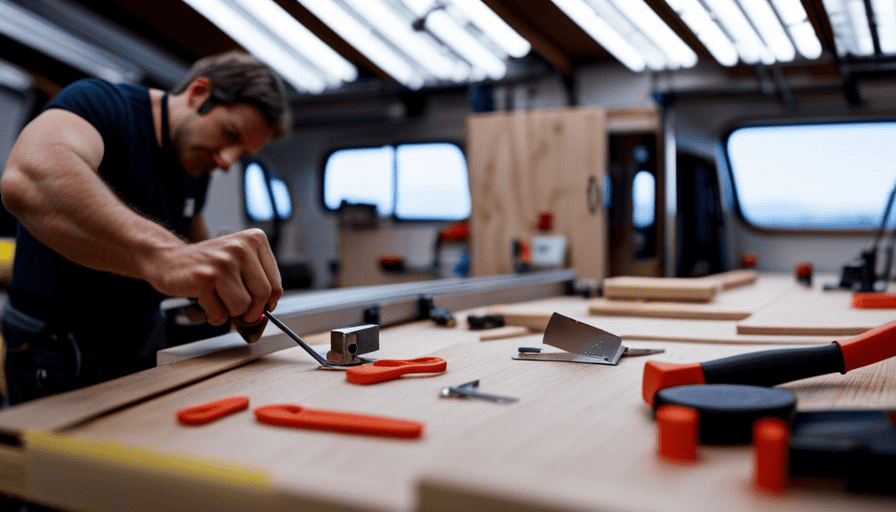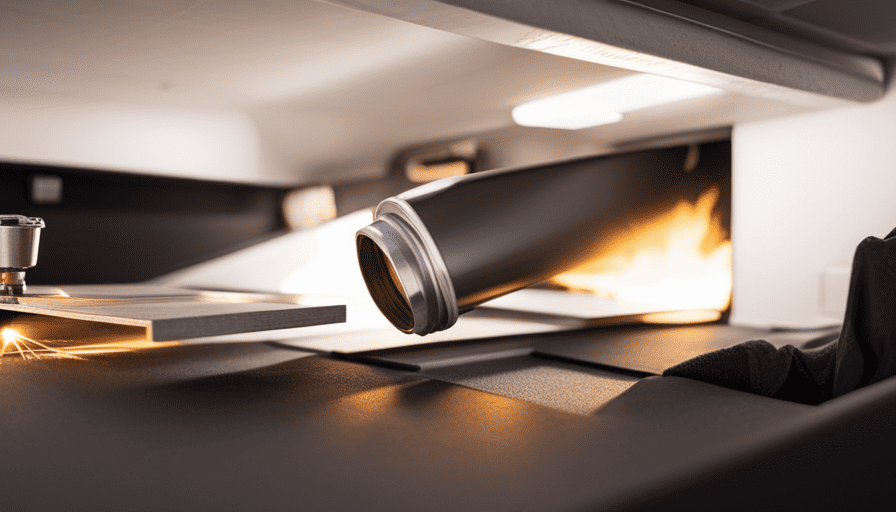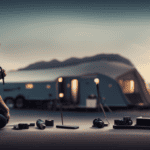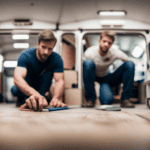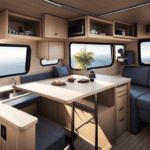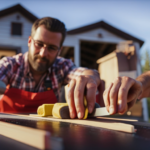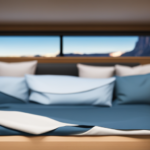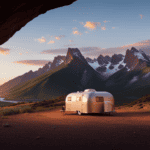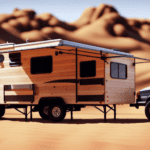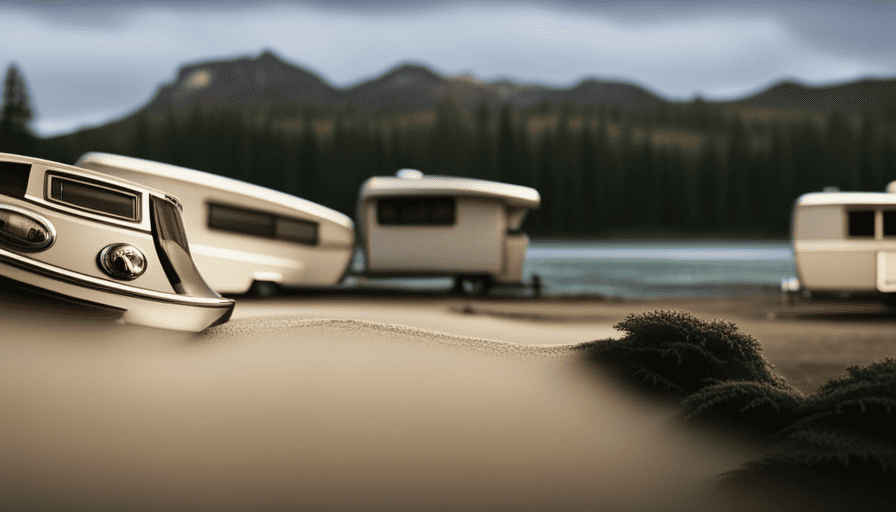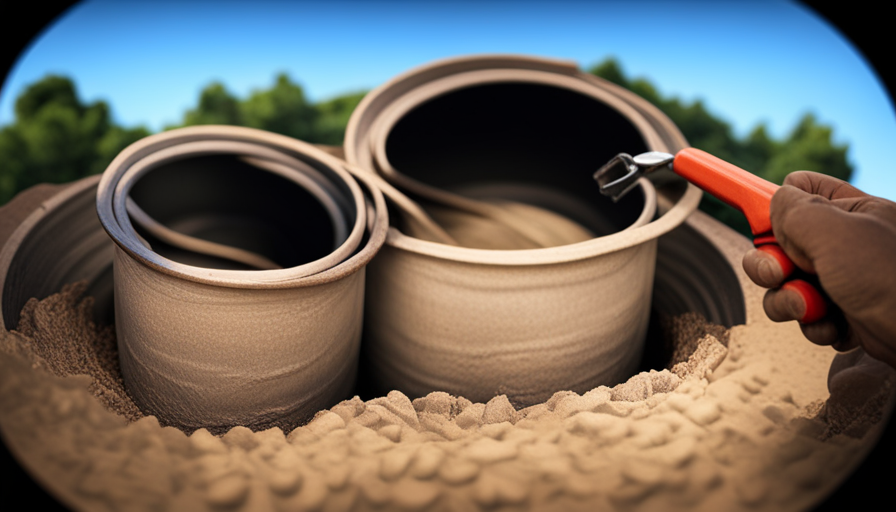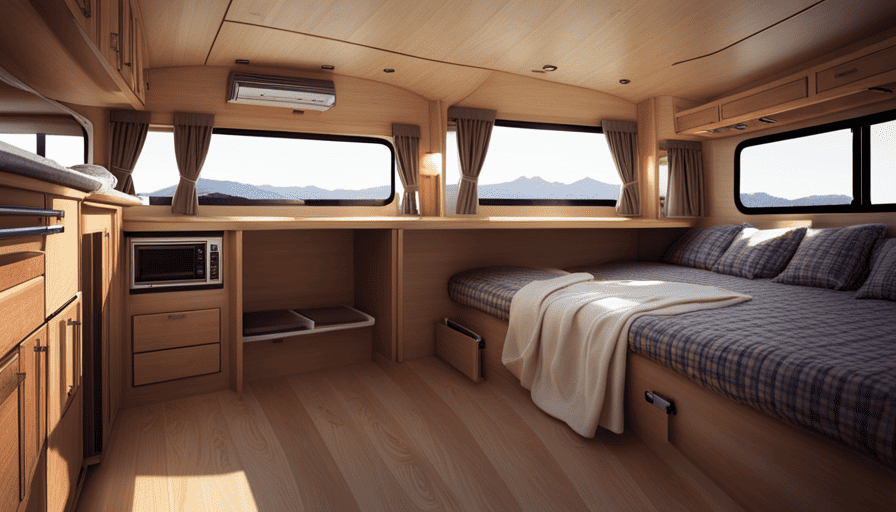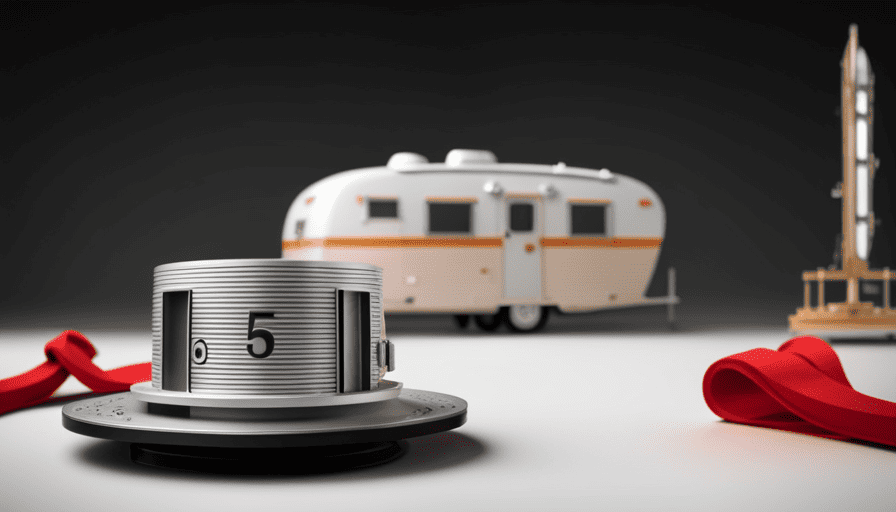Did you know that buying a new camper can cost anywhere from $10,000 to $100,000? For many outdoor enthusiasts looking to explore the great outdoors, this price range can be high. But what if I told you that you could build your own camper at a much lower cost?
That’s right, with a little bit of planning, creativity, and some handy DIY skills, you can create your very own home on wheels. In this article, I will guide you through the process of building a camper from scratch. From selecting the right vehicle to designing the interior layout, choosing energy-efficient appliances, and adding personal touches, I will provide you with all the knowledge and tips you need to create the camper of your dreams.
So, let’s get started on this exciting journey towards camper ownership!
Key Takeaways
- Building your own camper is a cost-effective option compared to buying one.
- When selecting a vehicle for camper conversion, consider factors like size, condition, mileage, and weight capacity.
- Plan the interior layout and design of the camper to ensure functionality and comfort, with enough storage space and windows.
- Install energy-efficient appliances and fixtures, and consider sustainable options like solar panels for electricity.
Selecting the Right Vehicle for Your Camper Conversion
Now, you’re probably wondering which vehicle is going to be the perfect fit for your epic camper conversion journey. Well, let me guide you through the process of selecting the right vehicle for your camper conversion.
The first thing you need to consider is the size of the vehicle. Are you looking for a compact van or a larger truck? This decision will depend on your personal preferences and the amount of space you need for your adventure.
Next, think about the vehicle’s condition and mileage. You want a reliable vehicle that won’t break down in the middle of nowhere. It’s also important to consider the cost of repairs and maintenance. Look for a vehicle with a good service history and low mileage if possible.
Consider the vehicle’s weight capacity as well. Your camper conversion will add weight to the vehicle, so you need to make sure it can handle the load. Check the manufacturer’s specifications to determine the maximum weight capacity.
Lastly, think about the vehicle’s layout and design. Does it have enough windows for natural light? Are there enough storage compartments for all your camping gear? Consider these factors when choosing your vehicle.
Now that you’ve selected the perfect vehicle for your camper conversion, it’s time to start planning the interior layout and design.
Planning the Interior Layout and Design
First, envision your dream home on wheels, like a cozy cabin nestled in the mountains. When planning the interior layout and design of your camper, it’s important to consider both functionality and comfort.
One key aspect to plan is the bathroom area. Depending on the size of your camper, you may have limited space for a bathroom. Consider incorporating a compact toilet, such as a cassette toilet or composting toilet, to save space. Additionally, installing a small shower or a wet bath can provide the convenience of a bathroom on the road.
Another crucial element in designing your camper’s interior is maximizing storage space. With limited square footage, it’s essential to make the most of every nook and cranny. Utilize overhead cabinets, under-bed storage, and built-in shelves to keep your belongings organized and easily accessible. Incorporate clever storage solutions like hanging organizers and collapsible furniture to further optimize space.
Now that you have planned the bathroom area and maximized storage space, it’s time to move on to building a comfortable sleeping area. By creating a cozy and inviting space to rest, you’ll be able to recharge and relax during your travels.
Building a Comfortable Sleeping Area
Creating a snug and inviting sleeping area is essential for a restful and rejuvenating experience during your travels. One of the most important aspects is choosing a comfortable mattress that provides adequate support and cushioning. Look for a mattress specifically designed for campers, as they’re often made with materials that are lightweight and durable. Memory foam mattresses are a popular choice, as they conform to your body shape and help alleviate pressure points.
In addition to a comfortable mattress, proper ventilation is crucial to ensure a good night’s sleep. Consider installing windows or vents near the sleeping area to allow for fresh air circulation. This’ll help prevent condensation and keep the space cool during hot summer nights. You can also invest in a fan or air conditioning unit to further enhance airflow and temperature control.
To make the sleeping area even more cozy, you can add some personal touches such as soft pillows, warm blankets, and dimmable lighting. These small details can create a peaceful and relaxing atmosphere that promotes deep sleep.
Now that we’ve created a comfortable sleeping area, let’s move on to creating a functional kitchen and dining space.
Creating a Functional Kitchen and Dining Space
To fully enjoy your travels, imagine yourself stepping into a practical and inviting kitchen and dining space, complete with a well-equipped cooking area and a cozy spot to savor your meals.
When it comes to building a camper, creating a functional kitchen is crucial. You’ll want to invest in space-saving appliances that still provide all the necessary functionality. Consider installing a compact refrigerator, a two-burner stove, and a small microwave to meet your cooking needs while on the road. Additionally, having ample storage space for your pots, pans, and utensils is essential to keep everything organized and easily accessible.
In terms of the dining area, opt for space-saving furniture such as a foldable table and chairs that can be easily stored when not in use. Additionally, consider incorporating built-in seating with hidden storage compartments to maximize the use of space. This will allow you to comfortably enjoy your meals without sacrificing precious square footage.
Now, let’s transition into designing a cozy living area where you can relax and unwind after a long day of exploring.
Designing a Cozy Living Area
Now, picture yourself stepping into a warm and inviting living space, where you can unwind and relax after your exciting adventures on the road. Designing a cozy living area in your camper is essential to creating a comfortable and homey atmosphere.
To achieve this, consider the following:
-
Cozy Lighting: Install soft and warm lighting fixtures throughout the living area. Use dimmable lights to create a relaxing ambiance in the evenings. Consider adding fairy lights or LED strips to add a touch of coziness.
-
Furniture Selection: Choose furniture that’s not only compact but also comfortable. Opt for a plush sofa or a comfortable recliner where you can kick back and relax. Use space-saving furniture that can double as storage, such as ottomans or coffee tables with hidden compartments.
-
Decorative Touches: Add personal touches to make the space feel like your own. Hang up pictures or artwork that reflects your style and personality. Incorporate cozy throw blankets and plush pillows to make the seating area even more inviting.
-
Functional Layout: Arrange the furniture in a way that maximizes the use of space. Consider a layout that allows for easy movement and access to other areas of the camper, such as the kitchen or bathroom.
Creating a cozy living area is just one step in the process of building your camper. The next section will cover the installation of electrical and plumbing systems, which are crucial for a fully functional and comfortable camper.
Installing Electrical and Plumbing Systems
Imagine stepping into your cozy living space and feeling instantly at home – that’s the power of installing electrical and plumbing systems in your camper. These essential systems ensure that you have access to electricity and water, providing convenience and comfort during your travels.
When it comes to electrical systems, installing solar panels can be a game-changer. Not only do they provide a sustainable source of energy, but they also allow you to be more self-sufficient on the road. By harnessing the power of the sun, you can charge your batteries and run various appliances without relying solely on campground hookups or generators. It’s a cost-effective and eco-friendly solution that enhances your camper experience.
In terms of plumbing, connecting to a water source is crucial for a functional camper. Whether you choose to hook up to a campground’s water supply or carry your own water tank, having a reliable system in place ensures you have access to clean water for cooking, cleaning, and personal hygiene. Additionally, installing a water pump and a water heater can further enhance your comfort, providing you with a steady flow of water at the desired temperature.
Now that you have your electrical and plumbing systems set up, the next step is choosing energy-efficient appliances and fixtures. By opting for energy-saving options, you can further reduce your environmental impact and maximize the efficiency of your camper. Transitioning into this topic, let’s explore how to select the perfect appliances and fixtures to make your camper even more eco-friendly and functional.
Choosing Energy-efficient Appliances and Fixtures
Enhance your camper experience by selecting energy-efficient appliances and fixtures that are as eco-friendly as a blooming garden. When it comes to lighting, opt for LED bulbs, which consume less energy and last longer than traditional incandescent bulbs. Not only will this help conserve energy, but it’ll also reduce the strain on your camper’s battery.
Additionally, consider installing motion sensor lights, so they only turn on when needed, saving even more electricity.
For water usage, choose water-saving fixtures such as low-flow faucets and showerheads. These fixtures are designed to minimize water consumption without compromising performance. By reducing water usage, you’ll not only conserve this precious resource but also extend the life of your water tanks, allowing for longer camping trips without the need for refilling.
Incorporating energy-efficient appliances and fixtures into your camper will not only benefit the environment but also save you money in the long run. Energy-efficient appliances, such as refrigerators and air conditioners, are designed to consume less electricity while still providing the same functionality. Look for appliances with Energy Star ratings, as they meet strict energy efficiency guidelines.
Transitioning into the subsequent section about adding storage solutions for organization, it’s important to maximize the space in your camper. By adding storage solutions, you can keep your belongings organized and easily accessible, making your camping experience more enjoyable and stress-free.
Adding Storage Solutions for Organization
Maximize your storage space in the camper by incorporating smart storage solutions for better organization and easy access to your belongings. When building a camper, it’s important to make the most of every inch of space available. Here are three key ways to maximize space and utilize vertical storage:
-
Install overhead cabinets: Utilize the vertical space above eye level to add extra storage. Install overhead cabinets above the kitchen area and along the walls to store items such as dishes, cookware, and dry goods.
-
Use hanging organizers: Hanging organizers are a fantastic way to keep smaller items organized and easily accessible. Hang them on the walls or inside cabinet doors to store items like utensils, cleaning supplies, and toiletries.
-
Get creative with under-bed storage: The area under the bed is often overlooked, but it can provide valuable storage space. Consider installing drawers or pull-out bins under the bed to store clothing, shoes, or outdoor gear.
By maximizing space and utilizing vertical storage, you can keep your camper organized and clutter-free. With everything in its place, you’ll have more room to personalize the camper with decor and accessories that reflect your style and make it feel like home.
Personalizing the Camper with Decor and Accessories
Make your camper feel like home by adding personal touches with decor and accessories that reflect your unique style and create a cozy and inviting atmosphere.
When it comes to camper decor ideas, the possibilities are endless. Start by choosing a color palette that suits your taste and creates a harmonious look throughout the space. Consider using removable wallpaper or decals to add pops of color and patterns to the walls. Hang curtains or blinds that not only provide privacy but also add a touch of elegance to your camper.
To make your camper even more personalized, invest in accessories that are both functional and stylish. A camper accessories shopping guide can help you find the perfect items to enhance your camping experience. Look for storage solutions that maximize space and keep your belongings organized. Consider adding throw pillows, blankets, and rugs to make your camper feel cozy and comfortable. Don’t forget about lighting – string lights or battery-powered lanterns can create a warm and inviting ambiance.
Personalizing your camper with decor and accessories is a fun and creative way to make it feel like home. By incorporating your unique style and adding functional items, you can create a cozy and inviting atmosphere that reflects your personality.
Now, let’s explore how to maintain and upgrade your camper for long-lasting enjoyment.
Maintaining and Upgrading Your Camper for Long-lasting Enjoyment
Maintaining and upgrading your camper is crucial for ensuring its longevity and continued enjoyment, as neglecting these tasks could lead to disastrous consequences and a less-than-ideal camping experience.
When it comes to maintaining the exterior of your camper, there are a few key things to keep in mind. Regularly inspect the roof for any signs of damage or leaks, and make sure to clean it regularly to prevent the buildup of dirt and debris. Additionally, check the seals around windows and doors to ensure they’re watertight. Investing in a good quality cover can also help protect your camper from the elements when it’s not in use.
In terms of upgrading your camper’s technology, there are countless options available to enhance your camping experience. Consider installing solar panels to power your camper, allowing you to enjoy off-grid adventures without relying on a generator. Upgrading your lighting system to energy-efficient LED lights can also save battery power.
In addition, investing in a quality sound system and entertainment center can make those rainy camping days more enjoyable. Don’t forget about safety upgrades as well, such as installing a backup camera for easier maneuvering and a tire pressure monitoring system for peace of mind on the road.
Maintaining and upgrading your camper doesn’t have to be a daunting task. By staying on top of regular maintenance and investing in technology upgrades, you can ensure that your camper remains in great shape for years to come, providing you with countless memorable camping experiences.
Frequently Asked Questions
How much does it cost to build a camper?
The cost to build a camper can vary depending on whether you choose a DIY approach or hire professionals for the conversion. DIY conversions can be more affordable, with costs ranging from $10,000 to $30,000, depending on the size and complexity of the project.
On the other hand, professional conversions can cost upwards of $50,000 or more. It’s important to carefully consider your budget and skills before deciding which route to take.
What tools and equipment are needed for a camper conversion?
When it comes to camper conversion tips, you’ll need a trusty set of tools and essential materials.
Picture this: a tool belt strapped around your waist, with a hammer, screwdriver, and power drill at the ready. These are just a few of the tools you’ll need to bring your dream camper to life.
As for materials, think insulation, plywood, and wiring supplies. With the right tools and materials, your camper conversion will be smooth sailing.
Can I legally live in a camper full-time?
Living in a camper full-time is an alternative living option that many people choose. However, there are zoning and legal considerations to keep in mind. Before making the decision, it’s important to research local laws and regulations regarding camper living. Some areas have specific restrictions on where you can park and live in a camper. It’s also important to consider access to utilities and amenities, as well as the potential need for permits or licenses.
Is it possible to build a camper without any previous construction experience?
It’s definitely possible to build a camper without any previous construction experience. In fact, many people find it to be a rewarding and fulfilling project. One interesting statistic is that DIY camper conversions have become increasingly popular, with a 107% rise in searches for ‘DIY camper conversions’ in the past year alone.
The benefits of DIY camper conversions include cost savings, customization options, and the satisfaction of creating something with your own hands.
Here are some tips for beginners in camper construction.
Are there any safety regulations or guidelines to consider when building a camper?
When it comes to camper construction, there are important safety regulations and guidelines to consider. These regulations ensure the safety of both builders and future occupants. It is crucial to follow proper construction techniques, such as using sturdy materials and reinforced joints, to ensure structural integrity.
Additionally, electrical and gas systems must be installed correctly, following safety standards. Adequate ventilation and fire safety measures are also essential.
Following these guidelines will help create a safe and secure camper.
Is It Necessary to Backup a Camper if You’re Building Your Own?
When building your own camper, it is essential to back up a camper. This ensures that in case of any mishap or miscalculation during construction, you have a fallback option. Backup a camper to protect your investment and provide peace of mind, knowing you have a reliable alternative for your travels.
Conclusion
In conclusion, building a camper is a rewarding and fulfilling project that allows you to create a personalized and comfortable home on wheels. Additionally, the process of designing and constructing your own camper allows you to incorporate unique features and design elements that cater to your specific needs and preferences. Whether it’s adding extra storage, customizing the interior layout, or integrating energy-efficient features, the possibilities are endless when building your own camper. And once the project is complete, it’s important to familiarize yourself with camper backup tips to ensure safe and efficient maneuvering while on the road. With the right planning and attention to detail, building a camper can truly be a labor of love that pays off in the form of unforgettable adventures and lasting memories.
By carefully selecting the right vehicle, planning the interior layout, and choosing energy-efficient appliances, you can create a functional and cozy living space.
Adding storage solutions and personal touches will enhance the camper’s organization and make it feel like home.
It’s important to maintain and upgrade your camper for long-lasting enjoyment. So, don’t hesitate to embark on this adventure and discover the truth behind the theory that building a camper is a fantastic way to explore the world with comfort and style.

